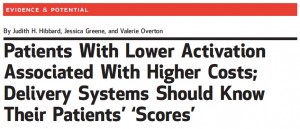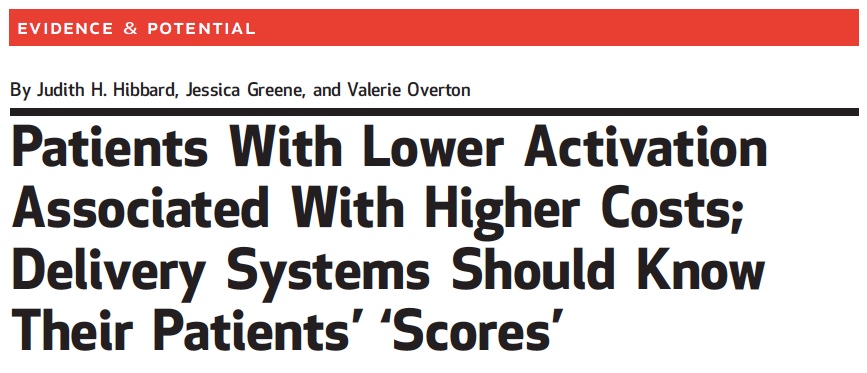 This article was part of the big Health Affairs issue “New Era of Patient Engagement” (Feb 2013) which Ileana Balcu blogged about at the time.
This article was part of the big Health Affairs issue “New Era of Patient Engagement” (Feb 2013) which Ileana Balcu blogged about at the time.
I’ve long been a fan of the Patient Activation Measure, which I wrote about here three years ago in The Patient Activation Measure (PAM): a framework for developing patient engagement. It’s a straightforward questionnaire that assesses how activated / awakened / engaged someone is regarding their health, and it has a full decade of robust studies demonstrating that a person’s PAM score predicts many different outcomes. It’s a heck of a tool. (No, I’m not involved with the company.)
Here, I want to report on an important paper in the Health Affairs policy journal on a new dimension (the cost of a person’s care), discuss the report’s probable policy impact, and propose that we take the concept an important step further.
Optional background: If you’re interested in understanding what makes a difference, I urge you to go read that post from three years ago, including its dozens of comments. They really get into what we know so far, and probe into what we think beyond that. Dr. Hibbard herself responded with great additional info.
First: what activation is (or more precisely, what the PAM measures)
From the post 3 years ago:
Thirteen questions are asked, and patients are scored as level 1, 2, 3 or 4:
- Does not yet believe they have active/important role
- Lack confidence and knowledge to take action
- Beginning to take action
- Maintaining behavior over time
Previous studies on the impact of activation (i.e. PAM score)
Dozens of studies have found correlations between PAM score and many measures, e.g.
The PAM has been successfully used to predict outcomes with a wide range of conditions including: serious mental health diagnosis, heart disease, multiple scelorisis, COPD, inflammatory bowel syndrome, hypertension, asthma, recovery after spine surgery, AIDS, and diabetes. Studies have also shown that the PAM is predictive of outcomes for those who are multi-morbid (4 or more conditions).
(Source: a comment on the original post by Dr. Hibbard; in a later comment she gave references.)
The current study
The full text is behind a paywall, but I subscribe… here’s the gist. From the abstract:
In an analysis of 33,163 patients … patients with the lowest activation levels had predicted average costs that were 8 percent higher in the base year and 21 percent higher in the first half of the next year than the costs of patients with the highest activation levels….
What’s more, patient activation was a significant predictor of cost even after adjustment for a commonly used “risk score” specifically designed to predict future costs.
The paper reports results for all patients, and separately for chronic conditions: high cholesterol, high blood pressure, etc. In almost every case there was a strong correlation between PAM score and how much the health system spent on the patient.
There’s real cause for optimism here, because
- In most cases the biggest improvement was from Level 1 (“why bother trying”) to Level 2 (“maybe I could try”), and
- The easiest PAM improvement is from Level 1 to 2
- Getting people from 1 to 2 is not a mystery – lots of research has established how to speak effectively to Level 1 people, and has shown that it works.
What motivates change in today’s health economy
As I say, reason for optimism. But notice something about the headline of this post vs the one on the article?
Article: Lower activation [is] associated with higher costs
This post: Activated patients cost *less*
I don’t know why the editors chose the negative phrasing, but I have a guess: My experience in Washington is that hospital managers are far more scared of costs these days than they used to be. This appears to be due to the Obamacare concept of “accountable care,” embedded in the bill. (Dartmouth’s Elliott Fisher is credited with inventing the term.) Under accountable care, health systems have become increasingly wary of avoidable costs.
I may focus on the opportunity side (“cost less”), but for the most part, people change behavior in response to a threat more than an opportunity. (As they say in behavioral economics, people are “risk-averse.”) So if you want people to change behavior, warn them of a risk – higher costs. Fine with me.
However you slice it, consider this: we now have evidence that when patients are engaged, it improves costs. We’ll need much, much more research to prove this 17 ways from Sunday, but now it’s Game On.
Can we go beyond obedience, to co-design?
To me real activation is not just when people do their part, it’s when people are thinking for themselves. That’s why on this blog, a few weeks before that 2011 PAM post, we suggested that fully engaged patients should “Design and create a safe, decent, patient centered healthcare system.”
See, our Society for Participatory Medicine talks about patients shifting “from being mere passengers to responsible drivers” of their health. To us, a really activated patient doesn’t just do great at following instructions (“compliance”), they take responsibility for the whole magilla – including, as many of our members will attest, defining their own priorities.
* * *
In any case, I for one am thrilled to see this addition to the evidence that it’s valuable to spend time helping patients get involved.
The PAM has one drawback compared to other methods, which always comes up, so I’ll measure it here: it’s a licensed commercial test, not a free download. (It’s sold by Insignia Health.) I’ll close with this, from the paper’s conclusion:
Patients who have more knowledge, skill, and confidence in managing their health, and who are more adept at navigating and using the health care system, appear to incur lower costs. …
An earlier analysis of this same study population showed that more highly activated patients were less likely to have an emergency department visit or a hospital stay, compared to less activated patients. …
The fact that patient activation predicts costs after demographics and condition severity, or health risk score, are controlled for indicates that even sicker patients can make a difference in their cost of care through their own actions and choices.
I’ll be blunt about this: I’ve been sick and tired of hearing so many of healthcare’s problems blamed on lazy patients, when achievement requires a partnership. Informed, competent health system managers now have new evidence that’s directly relevant to the bottom line. I hope this paper will help usher in an era of increased patient-provider partnership than we’ve ever seen before.







Recent Comments